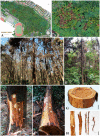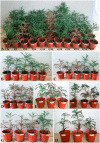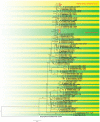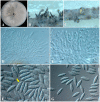Neofusicoccum cryptomeriae sp. nov. and N. parvum Cause Stem Basal Canker of Cryptomeria japonica in China
- PMID: 37108858
- PMCID: PMC10145188
- DOI: 10.3390/jof9040404
Neofusicoccum cryptomeriae sp. nov. and N. parvum Cause Stem Basal Canker of Cryptomeria japonica in China
Abstract
Cryptomeria japonica D. Don is a coniferous tree species widely grown in southern China for its high ornamental value. Recently, during disease surveys in China, a symptom of dieback occurred on C. japonica in Nanjing, Jiangsu Province, China. A total of 130 trees were surveyed and more than 90% showed the same symptom. The crowns of affected trees were brown when viewing from a distance, and the bark showed no difference from the healthy ones. In this study, 157 isolates were isolated from the 3 affected plants of C. japonica, and based on the living culture on PDA, the fungal isolates were preliminarily divided into 6 groups. Thirteen representative isolates were selected for the pathogenicity test, and seven of them showed obvious pathogenicity on C. japonica, causing stem basal canker. These isolates were identified based on comparisons of the DNA sequences of the internal transcribed spacer regions (ITS), partial translation elongation factor 1-alpha (tef1), β-tubulin (tub2), and DNA-directed RNA polymerase II subunit (rpb2) and combined with their morphological characteristics. Results showed that these seven isolates belong to two taxa in Neofusicoccum, including a species new to science. The new species, Neofusicoccum cryptomeriae, was hereby described and illustrated. The other species was N. parvum. Both species were pathogens of stem basal canker of Cryptomeria japonica.
Keywords: Cryptomeria japonica; Neofusicoccum; multi-locus phylogeny; new disease.
Conflict of interest statement
“Jiangsu PIESAT Information Technology Co., Ltd.” is Yuan-Zhi Si and Yi-Na Chen’s current work unit, and there is no conflict of interest.
Figures






References
-
- Yan Y., Wu X., Wang M., Li Z., Yuan M., Dai M., Wen Y. Complete chloroplast genomes of wild and cultivated Cryptomeria japonica var. sinensis. Biotechnol. Biotechnol. Eq. 2021;35:821–827. doi: 10.1080/13102818.2021.1932592. - DOI
-
- POWO Plants of the World Online. 2023. [(accessed on 10 February 2023)]. Available online: https://powo.science.kew.org/taxon/urn:lsid:ipni.org:names:261870-1.
-
- Zhejiang Department of Forestry Ancient and Famous Trees . Zhejiang Ancient and Famous Trees. Zhejiang Scientific and Technology Press; Hangzhou, China: 2001.
-
- Iizuka K., Toya N., Ohshima J., Ishiguri F., Miyamoto N., Aizawa M., Ohkubo T., Takenaka C., Yokota S. Relationship between Cs-137 concentration and potassium content in stem wood of Japanese cedar (Cryptomeria japonica) J. Wood Sci. 2018;64:59–64. doi: 10.1007/s10086-017-1673-9. - DOI
Grants and funding
LinkOut - more resources
Full Text Sources

